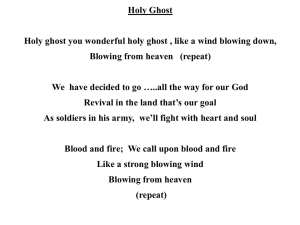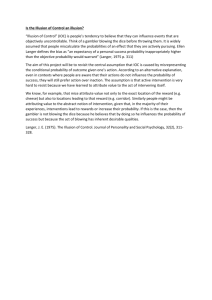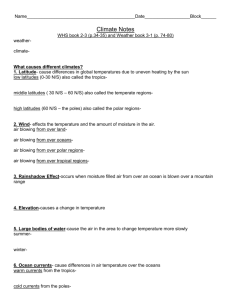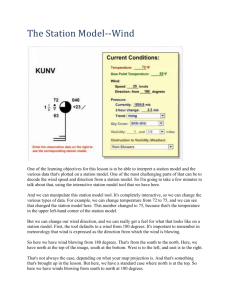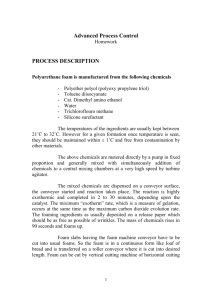Flammability performance of rigid polyurethane foam use of different
advertisement
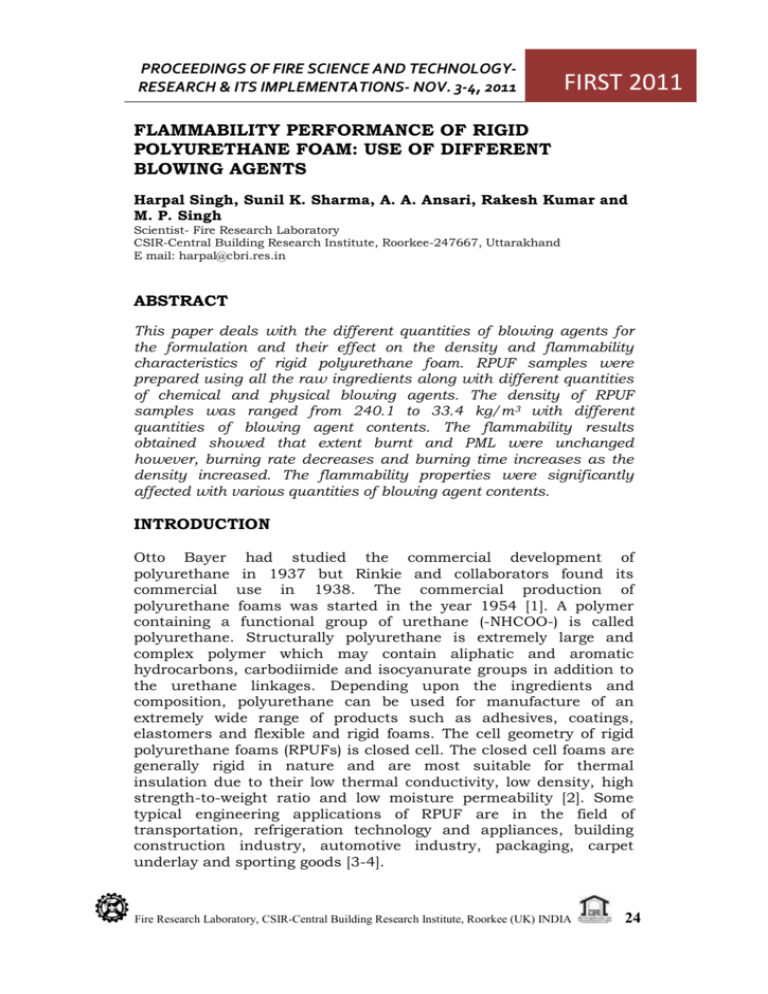
PROCEEDINGS OF FIRE SCIENCE AND TECHNOLOGYRESEARCH & ITS IMPLEMENTATIONS- NOV. 3-4, 2011 FIRST 2011 FLAMMABILITY PERFORMANCE OF RIGID POLYURETHANE FOAM: USE OF DIFFERENT BLOWING AGENTS Harpal Singh, Sunil K. Sharma, A. A. Ansari, Rakesh Kumar and M. P. Singh Scientist- Fire Research Laboratory CSIR-Central Building Research Institute, Roorkee-247667, Uttarakhand E mail: harpal@cbri.res.in ABSTRACT This paper deals with the different quantities of blowing agents for the formulation and their effect on the density and flammability characteristics of rigid polyurethane foam. RPUF samples were prepared using all the raw ingredients along with different quantities of chemical and physical blowing agents. The density of RPUF samples was ranged from 240.1 to 33.4 kg/m3 with different quantities of blowing agent contents. The flammability results obtained showed that extent burnt and PML were unchanged however, burning rate decreases and burning time increases as the density increased. The flammability properties were significantly affected with various quantities of blowing agent contents. INTRODUCTION Otto Bayer had studied the commercial development of polyurethane in 1937 but Rinkie and collaborators found its commercial use in 1938. The commercial production of polyurethane foams was started in the year 1954 [1]. A polymer containing a functional group of urethane (-NHCOO-) is called polyurethane. Structurally polyurethane is extremely large and complex polymer which may contain aliphatic and aromatic hydrocarbons, carbodiimide and isocyanurate groups in addition to the urethane linkages. Depending upon the ingredients and composition, polyurethane can be used for manufacture of an extremely wide range of products such as adhesives, coatings, elastomers and flexible and rigid foams. The cell geometry of rigid polyurethane foams (RPUFs) is closed cell. The closed cell foams are generally rigid in nature and are most suitable for thermal insulation due to their low thermal conductivity, low density, high strength-to-weight ratio and low moisture permeability [2]. Some typical engineering applications of RPUF are in the field of transportation, refrigeration technology and appliances, building construction industry, automotive industry, packaging, carpet underlay and sporting goods [3-4]. Fire Research Laboratory, CSIR-Central Building Research Institute, Roorkee (UK) INDIA 24 Flammability performance of rigid polyurethane foam: use of different blowing agents RPUF is prepared by mixing polyol with catalyst, surfactant, chain extender, chemical and physical blowing agents in the first stage. In the second stage blended polyol is mixed with diisocyanate to react. During mixing some air bubbles are introduced into the mixture and they serve as nuclei for foam cells. The nuclei turned into the bubbles are stabilized by silicone surfactant [2, 5]. The foaming of the RPUF can be carried out either by chemical blowing agent or physical blowing agent or by the mixture of chemical and physical blowing agents. Water is one of the most widely used as chemical blowing agent. The widely used physical blowing agents are chlorofluorocarbons and hydro chlorofluorocarbons. RPUF formation is principally based on the reaction of polyol with diisocyanate. The reaction is exothermic, and the heat of reaction is used to form a cellular structure by evaporation of the physical blowing agent. Isocyanate-urethane and isocyanate-urea reactions lead to the branching and cross-linking in the RPUF structure by forming allophanate and biuret respectively [2-4]. The present study deals with the use of different quantities of blowing agents during the preparation of RPUF. The effects of chemical blowing agent, physical blowing agent and mixture of chemical and physical blowing agents on density and flammability of RPUF samples were investigated. RPUF was prepared from diisocyanate and polyether polyol in the presence of amine catalyst, chain extender, surfactant, chemical and physical blowing agents. The effects of chemical and physical blowing agents were studied by varying their quantities during the preparation of RPUF samples. By varying the compositions and amount of chemical blowing agent, physical blowing agent and mixture of chemical and physical blowing agents, RPUF samples of various densities were obtained. The main aim of this study was to evaluate the influence of chemical blowing agent, physical blowing agent and mixture of chemical and physical blowing agents on density and flammability characteristics of RPUF samples using ASTM D1622 and BS: 4735 horizontal flammability test respectively. EXPERIMENTAL DETAILS RPUF Formulation Formulation of rigid polyurethane foam (RPUF) is basically based on polyether polyol, diisocyanate, amine catalyst (TED), surfactant, chain extender, chemical and physical blowing agents. The amount of polyether polyol was set to 100 parts by weight. The amount of diisocyanate required for the reaction with polyether polyol, chain extender and chemical blowing agent was calculated from their equivalent weights. About 5% weight excess diisocyanate was used for the completion of the reaction. This 5% weight excess Fire Research Laboratory, CSIR-Central Building Research Institute, Roorkee (UK) INDIA 25 Harpal Singh, Sunil K. Sharma, A. A. Ansari, Rakesh Kumar and M. P. Singh diisocyanate is calculated from isocyanate index (NCO/OH = 1.05) which is based on used number of equivalents of diisocyanate, polyether polyol and chemical blowing agent [3]. The amounts of amine catalyst and chemical blowing agent were varied to obtain desired cream time, gel time and tack-free time. The amounts of chemical and physical blowing agent were varied and calculated in order to obtain desired foam densities. The amounts of amine catalyst, surfactant, chain extender, chemical and physical blowing agents per 100 parts polyether polyol by weight (php) were selected as optimal after carried out a series of foam preparation experiments. The amount of chain extender can be varied depending upon the requirement of hard segment and cross-linking into the foam structure [6]. RPUF Sample Preparation RPUF samples with different amount (php) of ingredients were prepared through one-shot method [3-4]. Except diisocyanate, all the raw chemicals such as TED, surfactant, chain extender, chemical and physical blowing agents were first manually well blended with polyether polyol for 30 seconds in a stainless steel beaker. Then diisocyanate was added into the blended polyol and mixed for 20 seconds under overhead electric stirrer. After mixing, the reactants were discharged into an open mould (200200250 mm) lined with paper to produce free-rise foam. As the reactants mixture was poured into the mould, formation of many very small bubbles was observed which were dispersed into the reaction mixture. These tiny gas bubbles formed the nuclei into which the blowing gas diffused as the reaction proceeded. Number, size and distribution of the nuclei determine the final foam structure [7]. The foam cake was then cured for 48 hours at room temperature. Although foam can also be cured at elevated temperatures, however we preferred to perform the curing at room temperature to observe the foam properties at ambient processing conditions. The effect on RPUF densities blown by chemical, physical and mixture of chemical and physical blowing agents was investigated by varying their amounts. The amount of chemical blowing agent was varied from 0 to 3.0 php with an increment of 0.5 php. Similarly the amount of physical blowing agent was varied from 0 to 30 php with an increment of 5 php. The mixture of chemical and physical blowing agents was also used by varying the amount of one blowing agent, whereas, the amount of other blowing agent was constant and vice-versa. The amounts of amine catalyst, surfactant and 1, chain extender were fixed at 0.6, 1.0 and 20 php respectively with polyether polyol 100 parts by weight. The amount of diisocyanate required for the reaction with polyether polyol, chain extender and chemical blowing agent was calculated from their equivalent Fire Research Laboratory, CSIR-Central Building Research Institute, Roorkee (UK) INDIA 26 Flammability performance of rigid polyurethane foam: use of different blowing agents weights. For the completion of the reaction 5% excess (NCO/OH = 1.05) diisocyanate was used. When water is used as blowing agent, it reacts with CMDI to produce disubstituted urea and carbon dioxide. The carbon dioxide inflates the reactants which resulted into a cellular structure. Similarly methylene chloride when used as blowing agent, it boils and evaporates by the heat generated through exothermic reaction of CMDI and polyether polyol and inflates the reactants. Tables 1 and 2 show the chemical compositions of the RPUF samples, (RPUF-CB-PB) blown by chemical blowing agent, physical blowing agent and mixture of chemical and physical blowing agents respectively. In the sample codes, CB and PB denote the amounts of chemical blowing agent and physical blowing agent used respectively. Table 1 Chemical compositions of rigid polyurethane foam (RPUF-CB-PB) blown with chemical and physical blowing agent contents Sample codes (RPUF-CB-PB) Polyether polyol Diisocyanate TED 1, 4-BD Surfactant CB PB RPUF-0.0-0.0 100 172.8 0.6 20 1.0 0.0 0.0 RPUF-CB-0.0 100 180.6 0.6 20 1.0 0.5 0.0 RPUF-CB-0.0 100 188.4 0.6 20 1.0 1.0 0.0 RPUF-CB-0.0 100 196.2 0.6 20 1.0 1.5 0.0 RPUF-CB-0.0 100 204 0.6 20 1.0 2.0 0.0 RPUF-CB-0.0 100 211.9 0.6 20 1.0 2.5 0.0 RPUF-CB-0.0 100 219.7 0.6 20 1.0 3.0 0.0 RPUF-0.0-PB 100 172.8 0.6 20 1.0 0.0 5.0 RPUF-0.0-PB 100 172.8 0.6 20 1.0 0.0 10 RPUF-0.0-PB 100 172.8 0.6 20 1.0 0.0 15 RPUF-0.0-PB 100 172.8 0.6 20 1.0 0.0 20 RPUF-0.0-PB 100 172.8 0.6 20 1.0 0.0 25 RPUF-0.0-PB 100 172.8 0.6 20 1.0 0.0 30 The flammability characteristics of RPUF samples of dimensions 1505013 mm were evaluated by preparing samples with densities ranging from 40.39 to 168.83 kg/m 3. RPUF samples blown with 0.53.0 php chemical blowing agent in combination with 5-30 php physical blowing agent were also prepared for flammability characteristics investigation. RPUF samples were marked across their width by a line (gauge mark) 25 mm from one end. Fire Research Laboratory, CSIR-Central Building Research Institute, Roorkee (UK) INDIA 27 Harpal Singh, Sunil K. Sharma, A. A. Ansari, Rakesh Kumar and M. P. Singh Table 2 Chemical compositions of rigid polyurethane foam (RPUF-CB-PB) blown with chemical and physical blowing agents mixture Sample code (RPUF-CB-PB) Polyethe r polyol Diisocyanate TED 1, 4BD Surfactan t CB PB RPUF-0.0-0.0 100 172.8 0.6 20 1.0 0.0 0 - 0.0 RPUF-0.5-PB 100 180.6 0.6 20 1.0 0.5 5 – 30b RPUF-1.0-PB 100 188.4 0.6 20 1.0 1.0 5 – 30 RPUF-1.5-PB 100 196.2 0.6 20 1.0 1.5 5 - 30 RPUF-2.0-PB 100 204 0.6 20 1.0 2.0 5 - 30 RPUF-2.5-PB 100 211.9 0.6 20 1.0 2.5 5 - 30 RPUF-3.0-PB 100 219.7 0.6 20 1.0 3.0 5 - 30 Measurements The density of RPUF samples was measured according to ASTM D1622. The size (length width thickness) of the specimen was 30 30 30 mm respectively. RPUF specimens were conditioned at 250C and 55% relative humidity for 48 hours prior to their density measurement. The density of five specimens per sample was measured and averaged. The flammability characteristics of RPUF samples were evaluated according to BS: 4735. The specimens were weighed before placing horizontally on support gauge inside the non-combustible chamber. The farthest end away from gauge mark of the specimen was exposed for 60s to 10 mm diameter wing top fitted LPG burner of 38 mm non-luminous flame height. After complete fire exposure extent burnt, burning rate, percent mass loss (PML) and burning time of three specimens per sample were measured and averaged for analysis. RESULTS AND DISCUSSION Density Measurement The densities of RPUF samples blown with and without chemical and physical blowing agents and mixture of both blowing agents were measured. The density of RPUF samples in the absence of blowing agent was 240.1 kg/m3. The density of RPUF samples (RPUF-CB) blown by chemical blowing agent was decreased from 240.1 to 56.5 kg/m3, as the blowing agent content increased from 0 to 3.0 php respectively. The density of RPUF samples (RPUF-CB) blown by chemical blowing agent is shown in Fig. 1. Fire Research Laboratory, CSIR-Central Building Research Institute, Roorkee (UK) INDIA 28 Flammability performance of rigid polyurethane foam: use of different blowing agents 250 RPUF - Density Density (kg/m3) 200 150 100 50 0 0.0 0.5 1.0 1.5 2.0 2.5 3.0 Chemical blowing agent content (php) Fig. 1 Density of the RPUF samples blown by chemical blowing agent The density of the RPUF samples blown by physical blowing agent (RPUF-PB) and by the mixture of chemical and physical blowing agents (RPUF-CB-PB) is shown in Fig. 2. As shown in Fig. 2, the density of the RPUF samples blown by physical blowing agent decreased from 240.1 to 49.3 kg/m 3 as the content of physical blowing agent increased from 0 to 30 php, respectively. When mixture of chemical and physical blowing agents was used, the density of the RPUF samples (RPUF-CB-PB) varied from 240.1 to 33.4 kg/m3. Thus, it is quite clear that the density of RPUF samples decreased as the chemical and physical blowing agent contents increased. Flammability Characteristics The flammability of RPUF depends on its composition and closely related to the characteristics and quantity of chemical and physical blowing agents [8]. Flammability characteristics of RPUF samples were mainly measured from extent burnt, burning rate, percent mass loss (PML) and burning time obtained during the fire test. All these parameters are expressed in terms of average values. The variations of extent burnt and burning rate, PML and burning time of RPUF samples blown with various combinations of chemical and physical blowing agents are shown in Figs. 3 and 4 respectively. Fig. 3 presents the results which show that with an increasing content Fire Research Laboratory, CSIR-Central Building Research Institute, Roorkee (UK) INDIA 29 Harpal Singh, Sunil K. Sharma, A. A. Ansari, Rakesh Kumar and M. P. Singh of chemical blowing agent from 0.5 to 3.0, in combination with decreasing contents of physical blowing agent from 30 to 5, the extent burnt was unchanged, however, burning rate was increased from 1.13 to 2.52 mm/s. As shown in Fig. 4, with the similar combinations of chemical and physical blowing agents, PML was unchanged, whereas, burning time was reduced from 111 to 50s. These results reveal that increasing contents of chemical blowing agent increases the burning rate, whereas, increasing contents of physical blowing agent reduces the burning rate. 250 Density RPUF - 0.0-MC 200 RPUF - 0.5-MC RPUF - 1.0-MC Density (kg/m3) RPUF - 1.5-MC 150 RPUF - 2.0-MC RPUF - 2.5-MC RPUF - 3.0-MC 100 50 0 0 5 10 15 20 25 30 Fig. 2 Physical blowing agent content (php) Density of the RPUF samples blown by physical blowing agent and mixture of chemical and physical blowing agents As whole RPUF samples were consumed in fire, thus extent burnt and PML were unchanged. Thus, RPUF samples blown by physical blowing agent exhibit lower flammability level due to the chlorine atoms located in the polymer structure than samples blown with chemical blowing agent. These results are quite consistent with the previous research work carried out and reported in the literature [910]. The blowing agent content directly affects the density of RPUF. Density was found to be the key variable in controlling the flammability characteristics of RPUF [11]. The flammability characteristics such as extent burnt and burning rate, PML and burning time of RPUF samples of various densities are presented in Figs. 5 and 6 respectively. Fire Research Laboratory, CSIR-Central Building Research Institute, Roorkee (UK) INDIA 30 Flammability performance of rigid polyurethane foam: use of different blowing agents Physical Blowing Agent (php) 0.0 30 25 20 15 10 5.0 140 3.0 120 2.5 2.0 80 1.5 60 1.0 Burning Rate (mm/s) Extent Burnt (mm) 100 40 RPUF Extent burnt 20 0.5 RPUF Burning rate 0 0.0 0.0 0.5 1.0 1.5 2.0 2.5 3.0 Chemical Blowing Agent (php) Fig. 3 Extent burnt and burning rate of RPUF samples blown by chemical and physical blowing agents These results show that as the density increased from 40.39 to 168.83 kg/m3, extent burnt and PML were unchanged, whereas, burning rate was reduced from 2.56 to 1.10 mm/s and burning time was increased from 49 to 113s. As the density of RPUF samples increases, the porosity and thickness of skin layer of the samples decreased [11-14]. Due to the less porosity RPUF samples take more time to burn which results into decrease in the burning rate. During fire exposure the RPUF samples were burn to entire length, thus there was no change in the extent burnt and PML. All the flammability characteristics results reveal that RPUF samples blown by physical blowing agent have lowered flammability than the samples blown by chemical blowing agent. During flammability test, burning time and burning rate of RPUF samples were affected greatly, whereas, extent burnt and PML were remain unchanged. Fire Research Laboratory, CSIR-Central Building Research Institute, Roorkee (UK) INDIA 31 Harpal Singh, Sunil K. Sharma, A. A. Ansari, Rakesh Kumar and M. P. Singh Physical Blowing Agent (php) 30 25 20 15 10 5.0 100 125 80 100 60 75 40 50 PML (%) 150 Burning Time (s) 0.0 120 RPUF Mass loss RPUF Burning time 20 25 0 0 0.0 0.5 1.0 1.5 2.0 2.5 3.0 Chemical Blowing Agent (php) Fig. 4 PML and burning time of RPUF samples blown by chemical and physical blowing agents 140 3.00 120 2.50 2.00 80 1.50 60 1.00 Burning Rate (mm/s) Extent Burnt (mm) 100 40 RPUF Extent burnt 20 0.50 RPUF Burning rate 0 0.00 0 40 80 120 160 200 RPUF Density (kg/m3) Fig. 5 Effect of density on the extent burnt and burning rate of RPUF samples Fire Research Laboratory, CSIR-Central Building Research Institute, Roorkee (UK) INDIA 32 Flammability performance of rigid polyurethane foam: use of different blowing agents 125 150 125 PML (%) 100 75 75 50 Burning Time (s) 100 50 RPUF Mass loss RPUF Burning time 25 25 0 0 0 40 80 120 160 200 RPUF Density (kg/m3) Fig. 6 Effect of density on the PML and burning time of RPUF samples CONCLUSIONS The present study has led to the following conclusions. 1. RPUF samples were prepared with diisocyanate, polyether polyol, amine catalyst, surfactant, chain extender with chemical and physical blowing agents. 2. The density of RPUF samples blown by mixture of chemical and physical blowing agents was decreased sharply than the contents of chemical and physical blowing agent were used individually. 3. The content of chemical and physical blowing agents and so the density influence the flammability characteristics of RPUF. RPUF samples blown by physical blowing agent exhibit lowered flammability than the samples blown by chemical blowing agent. 4. The blowing agent contents and increase in the density affects mainly the burning time and burning rate, whereas, no change was observed in extent burnt and PML of the RPUF samples. Fire Research Laboratory, CSIR-Central Building Research Institute, Roorkee (UK) INDIA 33 Harpal Singh, Sunil K. Sharma, A. A. Ansari, Rakesh Kumar and M. P. Singh REFERENCES [1] [2] [3] [4] [5] [6] [7] [8] [9] [10] [11] [12] [13] [14] Wood, G. (1990), The ICI Polyurethane Handbook; 2 nd edition, John Wiley & Sons: New York. Benning, C. J. (1969), Plastic Foams, vol. 1; Principles of foam formation: polyurethane foam, John Wiley-Interscience and Sons, New York., pp 118-253. Szycher, M. (1999), Handbook of Polyurethanes; Rigid polyurethane foams, CRC Press, Washington DC., pp 8-1-46. Oertel, G. (1985), Polyurethane Handbook; Application of rigid PU foams, Hanser Publisher, New York., pp 273-314. Mondal, P., Khakhar, D. V, (2004), “Regulation of cell structure in water blown rigid polyurethane foam,” Macromol Symp, vol. 216, pp 241-254. Jung, H. C.; Kang, S. J.; Kim, W. N.; Lee, Y. R.; Choe, K. H.; Hong, S. H.; Kim, S. R. (2000), “Properties of crosslinked polyurethanes synthesized from 4, 4’-diphenylmethane diisocyanate and polyester polyol,” J Appl Polym Sci, vol. 78, pp 624-630. Kanner, B.; Decker, T. G. (1969), “Urethane foam formationrole of the silicone surfactant,” J Cell Plast, vol. 5, pp 32-39. Lefebvre, J., Bastin, B., Bras, M. L., Duquesne, S., Paleja, R. and Delobel, R, (2005), “Thermal stability and fire properties of conventional flexible polyurethane foam formulations,” Polym Degrad Stab: vol. 88, pp 28-34. Pielichowski, K., Slotwinska, D and Dziwinski, E, (2004), “Segmented MDI/HMDI-based polyurethanes with lowered flammability,” J Appl Polym Sci, vol. 91, pp 3214-3224. Checchin, M., Cecchini, C., Cellarosi, B. and Sam, F. O, (1999), “Use of cone calorimeter for evaluating fire performances of polyurethane foams,” Polym Degrad Stab, vol. 64, pp 573-576. Vanspeybroeck, R., Van Heas, P. and Vandevelde, P, (1993), “Combustion behaviour of polyurethane flexible foams under cone calorimetry test conditions,” Fire Mater: vol. 17, pp 155166. Modesti, M., Adriani, V. and Simioni, F, (2000), “Chemical and physical blowing agents in structural polyurethane foams: simulation and characterization,” Polym Eng and Sci, vol. 40(9), pp 2046-2057. Thirumal, M.; Khastgir, D.; Singha, N. K.; Manjunath, B. S.; Naik, Y. P, (2008), J Appl Polym Sci, vol. 108, pp. 1810-1817. Thirumal, M.; Singha, N. K.; Khastgir, D.; Manjunath, B. S.; Naik, Y. P, (2010), J Appl Polym Sci, vol. 116, pp. 2260-2268. Fire Research Laboratory, CSIR-Central Building Research Institute, Roorkee (UK) INDIA 34
